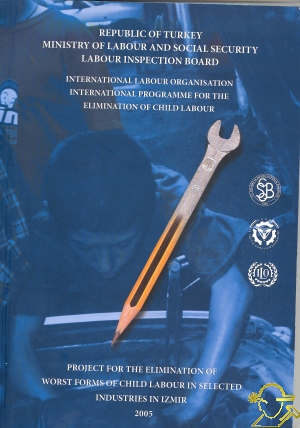International Labour Organization International Programme For The Elimination Of Child Labour
İÇİNDEKİLERTABLE OF CONTENTSIntroduction....................................................................................................................... Chapter 1: Working Children: An Overview................................................ 1.1 Introduction................................................................................................................. 1.2 Working Children in Turkey..................................................................................... 1.2.1. Population Distribution by Age............................................................................ 1.2.2. Distribution of Economically Active Children by Sector.................................. 1.2.3. Gender Dimensions of Child Labour................................................................... 1.2.4. Child Labour and Education................................................................................. 1.2.5 Reasons Why Children Work................................................................................. 1.3. Governmental and non-governmental agencies working against child labour. 1.3.1. Labour Inspection Board....................................................................................... 1.3.1.1. Supervision Policy................................................................................................ 1.3.1.2. Project Supervision Methodology..................................................................... 1.3.1.3. Projects Implemented by the LIB...................................................................... 1.3.2. Child Labour Unit (CLU)...................................................................................... 1.3.3. Ministry of National Education (MONE)........................................................... 1.3.4. Social Services and Child Protection Agency (SHQER).................................... 1.3.5. State Institute of Statistics (SIS)............................................................................. 1.3.6. General Directorate of Security............................................................................ 1.3.7. Southeastern Anatolia Project (GAP) Regional Development Administration..... 1.3.8. Confederation of Trades and Handicrafts (TESK)............................................. 1.3.9. Confederation of Employers' Organisations (TISK)......................................... 1.3.10. Trade Union Confederations.............................................................................. 1.3.11. Greater Ankara Municipality............................................................................. 1.3.12. Fi§ek Institute....................................................................................................... 1.3.13. Development Foundation of Turkey (TKV)..................................................... 1.3.14. Bilkent University................................................................................................ 1.3.15. Foundation for Vocational Training and Support to Small Industries (MEKSA)..... 1.3.16. Human Resources Development Foundation (IKGV)................................... 1.3.17. Women's Library and Documentation Centre Foundation............................ 1.3.18. Foundation of Social Workers............................................................................ 1.4. Legislative Framework for Combating Child Labour.......................................... 1.4.1. United Nations....................................................................................................... 1.4.2. European Council.................................................................................................. 1.4.3. European Union..................................................................................................... 1.4.4. International Labour Organisation...................................................................... 1.4.5. Turkish National Legislation................................................................................ Chapter 2: Project Justification, Objectives and Cooperation 2.1. Project Justification....................................................................................... 2.2. Project Objectives.......................................................................................... 2.2.2. Target Groups............................................................................................. 2.2.2.1. Primary Target Groups........................................................................... 2.2.2.2. Secondary Target Groups....................................................................... 2.2.3. Strategies..................................................................................................... 2.3. Project Administration/Co-operation........................................................ 2.3.1. Protocols with Partner Organizations........................................................................... 2.3.2. Central Steering Committee........................................................................................... 2.3.3. Izmir Provincial Committee for the Prevention of Child Labour (PCPCL)............, 2.3.4. Trade Union Action Committee..................................................................................... Chapter 3: Socio-Economic Characteristics of Working Children in Izmi Their Families: Baseline Survey Results.......................................... 3.1. Introduction.......................................................................................................................... 3.2. Characteristics of Working Children................................................................................. 3.2.1. Reasons Children Enter Work......................................................................................... 3.2.2. Ages at which Children Enter Work................................................................................ 3.2.3. Number of Workplaces and Reasons for Changing Workplaces................................. 3.2.4. Daily Working Hours........................................................................................................ 3.2.5. Size of Workplaces Employing Children......................................................................... 3.2.6. Wages and Other Benefits................................................................................................. 3.2.6.1. Wages .............................................................................................................................. 3.2.6.2. Other Benefits.................................................................................................................. 3.2.7. How Children Dispose of their Wages............................................................................, 3.2.8. Difficulties Children Face at the Workplace.................................................................... 3.2.8.1. Concept of Heavy Work.................................................................................................. 3.2.8.2. Negative Effects of Materials Used................................................................................. 3.2.8.3 Long Working Hours........................................................................................................ 3.2.8.4. Negative Treatment from Master Workers and Journeymen..................................... 3.2.8.5. Negative Effects of the Workplace on Children's Health............................................ 3.2.9. Leisure Activities of Working Children........................................................................... 3.2.10. Attitude Towards Present Situation and Expectations for the Future........................, 3.2.10.1. Degree of Satisfaction with Present Situation............................................................. 3.2.10.2. Children's Expectations for the Future......................................................................... 3.2.11. Working Children and Education................................................................................... 3.2.11.1. Reasons Working Children Drop out of School......................................................... 3.2.11.2. School Re-enrollment Among Working Children..................................................... 3.2.11.3. School vs. Work............................................................................................................... 3.2.11.4. Families' Attitudes Towards Education........................................................................, 3.2.11.5. Families' Attitudes Towards Child's School Re-enrollment....................................... 3.3. Additional Characteristics of Families of Working Children............................................. 3.3.1. Household Incomes.............................................................................................................. 3.3.2. Families Preference for the Occupation of Children........................................................ Chapter 4: Improving Working Conditions and Work Environme in the Target Sectors: Labour Inspector's Observatk Recommendations and Impact................................................................. 4.1 Overview .................................................................................................................................. 4.2, Auto Repair and Maintenance Situation Analysis................................................................ 4.2.1. Overview................................................................................................................................. 4.2.2. Workplace Size and Status.................................................................................................... 4.2.3. Production Process................................................................................................................ 4.2.3.1. Description of Work........................................................................................................... 4.2.3.2. Tools/Equipment................................................................................ 4.2.3.3. Inputs (Materials)/Outputs (Products)........................................... 4.2.4. Data Relating to Employees, Including Working Children............. 4.2.4.1. Ages at which Children Start Work................................................ 4.2.4.2. Activities in which Children Participate......................................... 4.2.4.3. Children's Perceptions of Difficulties Associated with Work...... 4.2.5. Risks ................................................................................................. 4.2.5.1 Risks from Working Conditions...................................................... 4.2.5.2 Risks from the Work Environment.................................................. 4.2.5.3. Risks from Work Relations.............................................................. 4.2.6. Recommendations for Reducing/Eliminating Risks....................... 4.2.7. Improvements in Working Conditions and Environments:........... 4.3. Situation Analysis: Garment/Textile Sector......................................... 4.3.1 Overview................................................................................................ 4.3.2. Workplace Size and Status.................................................................. 4.3.3. Production Process.............................................................................. 4.3.3.1. Description of Work......................................................................... 4.3.4.2. Tools/Equipment............................................................................... 4.3.3.3. Inputs (Materials)/Outputs (Products).......................................... 4.3.4. Data Relating to Employees, Including Working Children............ 4.3.4.1. Ages at which Children Start Work................................................ 4.3.4.2. Activities in which Children Participate........................................ 4.3.4.3. Children's Perceptions of Difficulties Associated with Work...... 4.3.5. Risks ................................................................................................ 4.3.5.1. Risks from Working Conditions..................................................... 4.3.5.2. Risks from the Work Environment................................................. 4.3.5.3. Risks from Work Relations.............................................................. 4.3.6. Recommendations for Reducing/Eliminating Risks....................... 4.3.7. Improvements in Working Conditions and Work Environments. 4.4. Situation Analysis: Footwear Sector..................................................... 4.4.1. Overview............................................................................................... 4.4.2. Workplace Size and Status.................................................................. 4.4.3. Production Process.............................................................................. 4.4.3.1. Description of Work......................................................................... 4.4.3.2. Tools/Equipment............................................................................... 4.4.3.3. Inputs (Materials)/Outputs (Products).......................................... 4.4.4. Data Relating to Employees, Including Working Children............ 4.4.4.1. Ages at which Children Start Work................................................ 4.4.4.2. Activities in which Children Participate........................................ 4.4.4.3. Children's Perceptions of Difficulties Associated with Work...... 4.4.5. Risks ................................................................................................ 4.4.5.1. Risks from Working Conditions..................................................... 4.4.5.2. Risks from the Work Environment................................................ 4.4.5.3. Risks from Work Relations............................................................. 4.4.6. Recommendations for Reducing/Eliminating Risks......................, 4.4.7. Improvements in Working Conditions and Work Environments. Chapter 5: Izmir Social Support Centre: Providing Services to V Children and their Families.............................................................. 5.1. Establishment and Operation of the SSC...................................................................... 5.2. Directing Working Children and their Siblings into Education................................. 5.2.1. Background..................................................................................................................... 5.2.2. Activities.......................................................................................................................... 5.2.2.1. Working Children Under 15...................................................................................... 5.2.2.2. Working Children Ages 15-18................................................................................... 5.2.2.3. Siblings of Working Children.................................................................................... 5.3. Psycho-Social Rehabilitation of Working Children...................................................... 5.4. Provision of Health Services to Working Children...................................................... 5.5. Monitoring Mechanisms.................................................................................................. 5.5.1. Provincial Committee for the Prevention of Child Labour...................................... 5.5.2. Workplace Monitoring Committee............................................................................. 5.5.3. Social Support Centre.................................................................................................... 5.6. Awareness Raising............................................................................................................. 5.7 Project Activities Targeting Families of Working Children.......................................... 5.7.1. Data on families and intra-familial relations of working children.......................... 5.7.2. Training for Families..................................................................................................... 5.7.3. Health Services to Families........................................................................................... 5.7.4. Income-Generation Activities for Families................................................................ 5.7.4.1. Handicrafts Courses................................................................................................... 5.7.4.2. Job Placement for the Disabled and Ex-Convicts................................................... 5.7.4.3. Vocational Courses with Employment Guarantee................................................. 5.8. Evaluation and Recommendations................................................................................. 5.8.1 Education......................................................................................................................... 5.8.2. Psycho-Social Services................................................................................................... 5.8.3. Health Services............................................................................................................... 5.8.4. Monitoring...................................................................................................................... 5.8.5. Awareness Raising.......................................................................................................... 5.8.6. Support for Families...................................................................................................... Chapter 6: Conclusion..................................................................................................... Annex I Tepecik Training Hospital Health Screening Report..........................................., Bibliography..............................................................................................................................    |



